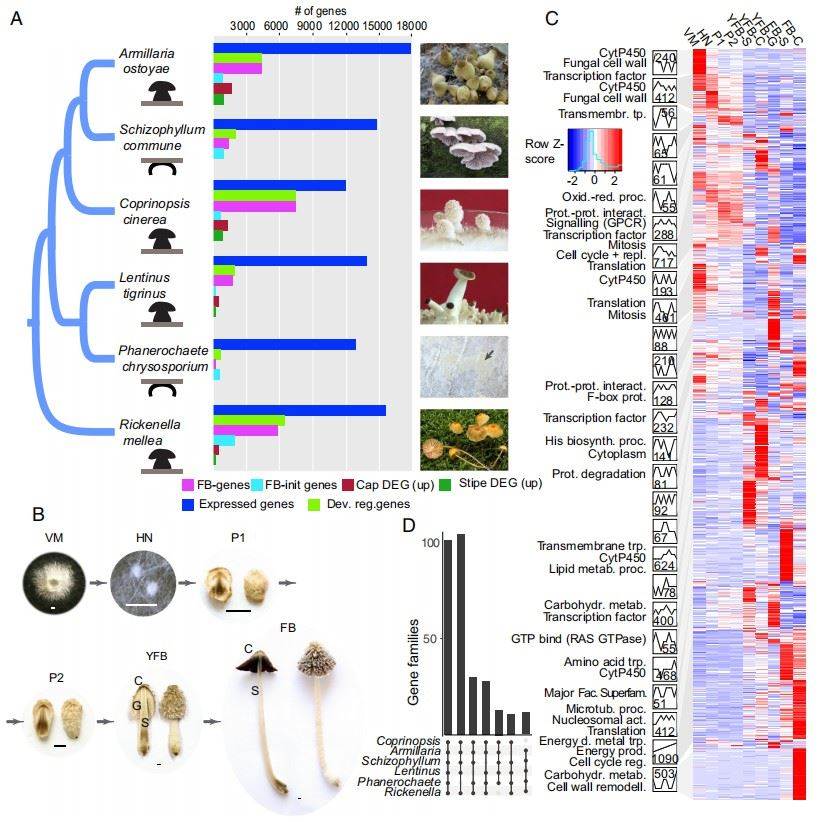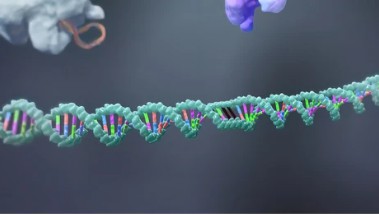A transcriptome is the complete set of transcripts in a particular organism or the sum of all gene transcripts in a particular cell type. Although the genome of a given cell line is immutable, external environmental conditions can cause significant changes in the transcriptome. Transcriptomics technology is widely used to study the transcription of all organisms’ genes and the overall level of transcriptional regulation involved. This technology can also be used to find key genes in the metabolic process of organisms and is an important means of subsequent gene cloning and functional verification. Mushrooms produce defense proteins and secondary metabolites to fight predators and competitors. However, little is known about the correlation between the tissue-specific expression of these molecules and target organism specificity.
 Fig. 1. Overview of the developmental mushroom transcriptomes. (Krizsán K, et al., 2019)
Fig. 1. Overview of the developmental mushroom transcriptomes. (Krizsán K, et al., 2019)
Services

Lifeasible offers comprehensive mushroom transcriptomics services to sequence and assemble whole-genome transcriptomes of a wide range of mushrooms, comparing and screening genes up-and down-regulated in different environments, tissues, and growth and developmental stages. Our experts perform functional annotation and clustering of differentially expressed genes to explore environmental response mechanisms and the growth and developmental mechanisms of mushrooms.
We can perform transcriptomic analysis on various mushrooms, including C. militaris, G. lucidum, V. volvacea, P. ostreatus, Ophiocordyceps sinensis, H. erinaceus, F. filiformis, A. cinnamonomea, P. eryngii, Termitomyces albuminosus, L. edodes, and L. rhinocerotis, etc. Our mushroom transcriptome services include:
- Mushroom Transcriptomics in Different Environments
Mushrooms are susceptible to environmental factors such as hormones, light, and temperature during growth. These factors seriously affect primordial development, differentiation of substrates, and coloration of mycelium after maturation. We provide transcriptomics techniques to screen mushroom-specific expressed genes under different treatments and explore their stress response mechanisms to maintain normal growth and development of edible mushrooms in response to changes in the external environment.
- Mushroom Transcriptomics in Different Tissues
Mushroom mycelium can be divided into mononuclear, binuclear, and multinuclear mycelium. We offer a differential transcriptome service for mono- and binucleate mushroom mycelium, and the degradation of mycelium during successive cultures, to help you analyze the advantages of mono- and binucleate mycelium during growth and development.
- Mushroom Transcriptomics in Different Developmental Stages
We can perform transcriptional sequencing of various mushrooms at different growth and developmental periods, identify genes differentially expressed at different periods, and perform functional annotation to analyze their expression patterns during different growth periods. This service can help our customers to understand the physiological changes and material accumulation processes of mushrooms during growth from the transcriptome level.
Applications of Our Mushroom Transcriptomics
- Providing a better understanding of different developmental stages.
- Elucidating key biosynthetic and developmental pathways.
- Identifying candidate targets for metabolic engineering purposes.
- Providing useful information for molecular breeding.
- Analyzing differences in gene expression under different culture conditions.
Our Transcriptomics Technology Platforms
- Gene chip technology.
- Sequence analysis of gene expression (SAGE).
- High-throughput transcriptome sequencing technology (RNA-Seq).
- Based on DNA microarray technology.
We will select the best combination of methods according to the different research objectives of our clients. We can screen a large number of differentially expressed genes based on genomics technology, which brings mushroom research to a new research stage. Our goal is to explore the internal changes of mushrooms at the transcriptome level in different environments, tissues, and growth and development periods. If you are interested in our services, please contact us.
Reference
- Krizsán K, et al. (2019) Transcriptomic atlas of mushroom development reveals conserved genes behind complex multicellularity in fungi[J]. Proceedings of the National Academy of Sciences. 116(15): 7409-7418.
For research or industrial raw materials, not for personal medical use!


 Fig. 1. Overview of the developmental mushroom transcriptomes. (Krizsán K, et al., 2019)
Fig. 1. Overview of the developmental mushroom transcriptomes. (Krizsán K, et al., 2019) 
